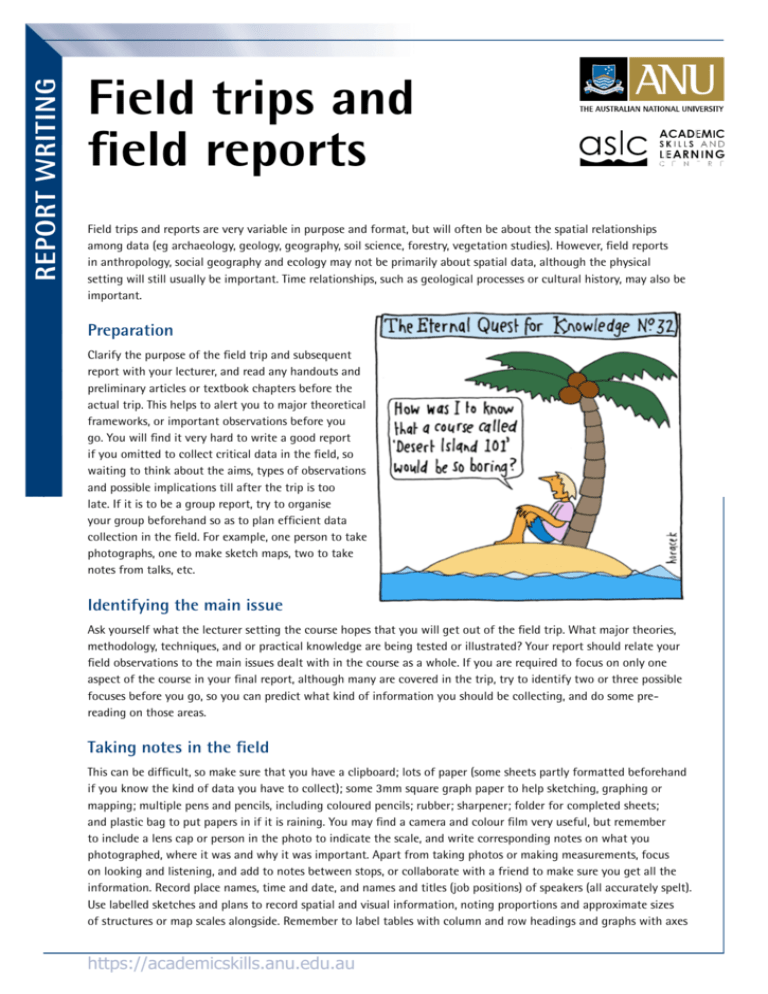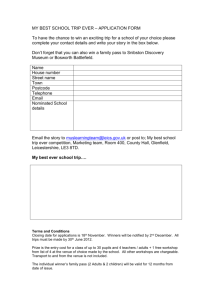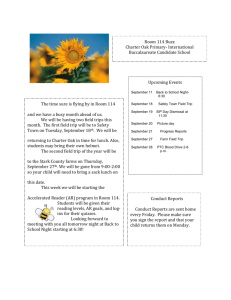g Field trips and field reports - Academic Skills & Learning Centre
advertisement

report writing Field trips and field reports Field trips and reports are very variable in purpose and format, but will often be about the spatial relationships among data (eg archaeology, geology, geography, soil science, forestry, vegetation studies). However, field reports in anthropology, social geography and ecology may not be primarily about spatial data, although the physical setting will still usually be important. Time relationships, such as geological processes or cultural history, may also be important. Preparation Clarify the purpose of the field trip and subsequent report with your lecturer, and read any handouts and preliminary articles or textbook chapters before the actual trip. This helps to alert you to major theoretical frameworks, or important observations before you go. You will find it very hard to write a good report if you omitted to collect critical data in the field, so waiting to think about the aims, types of observations and possible implications till after the trip is too late. If it is to be a group report, try to organise your group beforehand so as to plan efficient data collection in the field. For example, one person to take photographs, one to make sketch maps, two to take notes from talks, etc. Identifying the main issue Ask yourself what the lecturer setting the course hopes that you will get out of the field trip. What major theories, methodology, techniques, and or practical knowledge are being tested or illustrated? Your report should relate your field observations to the main issues dealt with in the course as a whole. If you are required to focus on only one aspect of the course in your final report, although many are covered in the trip, try to identify two or three possible focuses before you go, so you can predict what kind of information you should be collecting, and do some prereading on those areas. Taking notes in the field This can be difficult, so make sure that you have a clipboard; lots of paper (some sheets partly formatted beforehand if you know the kind of data you have to collect); some 3mm square graph paper to help sketching, graphing or mapping; multiple pens and pencils, including coloured pencils; rubber; sharpener; folder for completed sheets; and plastic bag to put papers in if it is raining. You may find a camera and colour film very useful, but remember to include a lens cap or person in the photo to indicate the scale, and write corresponding notes on what you photographed, where it was and why it was important. Apart from taking photos or making measurements, focus on looking and listening, and add to notes between stops, or collaborate with a friend to make sure you get all the information. Record place names, time and date, and names and titles (job positions) of speakers (all accurately spelt). Use labelled sketches and plans to record spatial and visual information, noting proportions and approximate sizes of structures or map scales alongside. Remember to label tables with column and row headings and graphs with axes https://academicskills.anu.edu.au and titles, and to include the unit with all measurements. Report format Experimental field work can be written up in the introduction-methods-results-discussion format. For observational data, the format can be varied to help the reader find the information and make a logical "story" leading to your conclusions. There will still be an introduction, setting out the purpose of the field work and usually containing sub-sections which give relevant background information (location of area, geology, topography, vegetation, climate, geological history, recent history etc). It will also be necessary to review relevant literature on the topic. If particular methods were used to collect the data, then these will be described next, followed by presentation of the data and then interpretation and discussion. For trips involving many locations, it may be easiest to organise the background information, data, and interpretation by site, but then draw all the sites together in a general discussion at the end. Do whichever involves least repetition of information and makes the report easiest for the reader to understand and follow. Use descriptive subheadings to make the information easy to find. Data presentation The types of data obtained in the field may be experimental (ie an effort has been made to control or eliminate variables/factors which are not the subject of study) or observational (that is, data is collected with no attempt to control or eliminate any influence, and some influences may not even be known). In the latter case, any conclusions about causal relationships you can draw will be quite tentative, whereas a well-designed experiment or field-trial will allow you to eliminate some possible explanations of the results. Besides the usual tables and graphs, data may include photos, diagrams, sketches, maps, transects, quadrants, or interviews. To make a professional-looking job of your final report (and allow easier editing) you may wish to learn how to use computer-based graphing or drawing applications. However, neat hand-drawn diagrams are usually acceptable. In either case make sure you provide all the relevant information – full descriptive titles, scales, units of measurement, keys to colours and shading, labels, and acknowledgment if the figure is based on a published source. Discussion The discussion argues towards any conclusions that can be drawn from the data and/or possible explanations for observations made on the trip. In this way it relates the observations back to the theory covered in the unit. So, for example, for a trip to look at regional geology, you would discuss how each observation either supports or is incongruous with the published tectonic history. Relate the observations to central discipline issues – how do the observations go together to allow inferences about events which may have occurred in the distant past on a vast scale? Obviously, to do the discussion well you will need to refer to the literature on the subject. The discussion will also critically evaluate the data collection methods - what are the assumptions, limitations and usefulness of different methods? Remember, however, that any information is better than none and that there is often a trade-off between the accuracy and reliability of data and the amount that can be collected, so that when surveying an area some compromises may be necessary between many less accurate measurements made over a large area or at a close enough density to allow inferences about an aspect of the study, and fewer, more accurate measures. In other words, don't be over-critical. Try to ensure that your data collection methods are good in the first place, as statements such as "the results are skewed due to the inaccurate readings" always look unimpressive. If you do have serious reservations about the data, then explain what results you expected to see and why, so that the examiner at least has evidence of your clear understanding and thinking. Conclusions and recommendations Depending on the purpose and format of your report, you may have a separate conclusions section to summarise the major findings. If the study and report are intended to solve a problem, you will also have recommendations (as any professional report would). These state the implications of your findings in practical terms, eg: "Soil erosion problems in the catchment are related to salinisation, loss of structure due to low organic matter and low vegetation cover. https://academicskills.anu.edu.au It is therefore recommended that tree cover be restored in the upper catchment, and that the lower catchment be managed with longer rotations including green manure crops such as lupins." ANU CRICOS Provider Number 00120C © 2009 Academic Skills and Learning Centre (ASLC), The Australian National University. Excepting the © Horacek cartoon, this handout may be used and changed for educational purposes, so long as ASLC is appropriately acknowledged. https://academicskills.anu.edu.au






